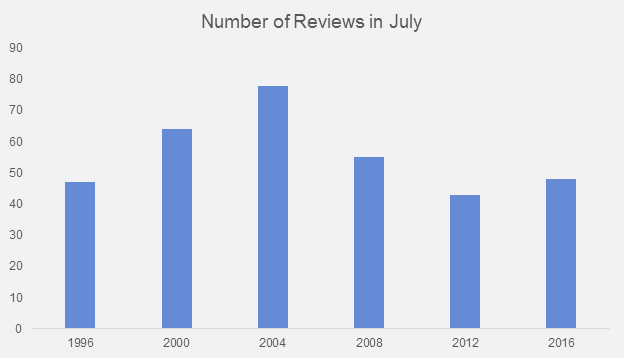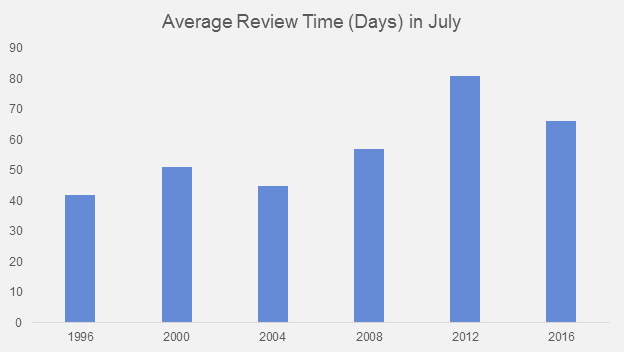Insight
August 4, 2016
Charting Midnight Regulation Before Dawn: July
There was something in the water in 2004. This past month saw pedestrian regulatory output, with the exception of significant rulemakings, but July of 2004 produced a record number of regulatory approvals.
In our series tracking regulation in the final year of the Obama Administration, this month once again proved the administration is on a record pace to issue significant regulation. Last month, the administration approved 17 significant rules and that figure declined slightly to 15 in July, but still more than any comparable period in the past 20 years.
Through the first seven months of this year, regulators have approved 92 significant rulemakings; the next two closest years were 2008 and 2004, when regulators approved just 68 and 55 significant rulemakings in the first half. In other words, the White House has approved 35 percent more significant regulatory action than any comparable period since 1996.
With less than a year for President Obama to regulate, this is his midnight year for regulation. Although it’s not the official midnight period yet (defined as the period after Election Day, but before the next president takes office), each month the American Action Forum (AAF) will highlight the final regulatory activity of the administration and compare it to similar times in the past. This monthly series will highlight all of the rules leaving the White House scheduled for official publication, all economically significant measures, the length of time for White House review, the number of rules rejected or withdrawn from the rulemaking process, and the monthly cost of federal regulatory activity.
July 2016
Something happened in the summer of 2004. In July of that year, the Office of Information and Regulatory Affairs (OIRA), the branch of the White House in charge of reviewing cabinet-agency regulation, approved 78 rulemakings, a record for presidential election year output … so far. There were only 22 working days that month, so staffers went through nearly three rules per day. OIRA concluded review of just 48 rules in July of this year. July of 2012 was the low point, with just 43 new rulemakings. The chart below tracks overall regulatory activity during these midnight years.
However, for economically significant measures, July of 2016 led the way. OIRA concluded review of 15 significant measures; this compares to 14 significant rules in 2008, eight in 2012, and seven in 2004, 2000, and 1996. Below are just some of the notable regulations released last month:
- Arctic Drilling Regulations
- Efficiency Standards for Power Supplies
- Formaldehyde Emissions Standards
- Flammable Liquids and Rail Tank Cars
Despite the output of 15 significant measures, there are still 29 economically significant measures pending review (as of this writing), the same figure from last month, so agencies continue to add notable rulemakings at the White House. In July, OIRA received 32 additional measures that are still pending review (including seven significant rules).
Once again, OIRA concluded review of several rules that had been under review for more than 120 days, which is the generally allowed timeframe for White House review under current executive orders. OIRA discharged eight rulemakings that had been under review for more than 120 days, including “Airport Safety Management,” which had been under review for 328 days.
Bucking a trend, this July did not eclipse all other similar periods during presidential election years for average review times. That title belonged to July of 2012, which yielded an average review time of 81 days. The average review time this month was 66 days, compared to a low mean of 42 days in July of 1996. However, the outlier review time of 328 days, mentioned above, skewed the data. The median review time in July 2016 was a more pedestrian 42 days; July 2012 had a median of 45 days, a difference of 44 percent (from the average of 81 days).
For comparison, the chart below tracks the average review time since 1996 during midnight years.
With regard to “withdrawn” rulemakings, or measures that agencies and OIRA pull back from review, there were none in July. In contrast, there were two withdrawn measures in 2012, three in 2008 and 1996, and four in 2004 and 2000. There is an obvious disincentive for agencies to withdraw rules this late during an administration and the White House has not aggressively pulled back regulations from review, at least compared to other similar periods.
The Cost
Thanks to AAF’s Reg Rodeo tool, the public can track regulatory costs and paperwork burdens over time, including data on major rules, Dodd-Frank, and the Affordable Care Act. In July 2016, regulators finalized $5.9 billion in costs, up from $4.3 billion in June, and down from $22 billion in May. How does this compare to other similar periods? Although not a presidential election year, in July 2015, regulators published just $930 million in costs. In terms of paperwork, regulators published 11.5 million final hours this July, compared to July 2015, with 4.4 million hours.
Finally, there is the ultimate question of President Obama’s regulatory legacy. Through this point in his presidency (July of 2008), President George W. Bush had issued 426 major rules. By contrast, President Obama has issued 602, or 41 percent more than his predecessor. AAF will continue to publish monthly updates of similar periods in history.












